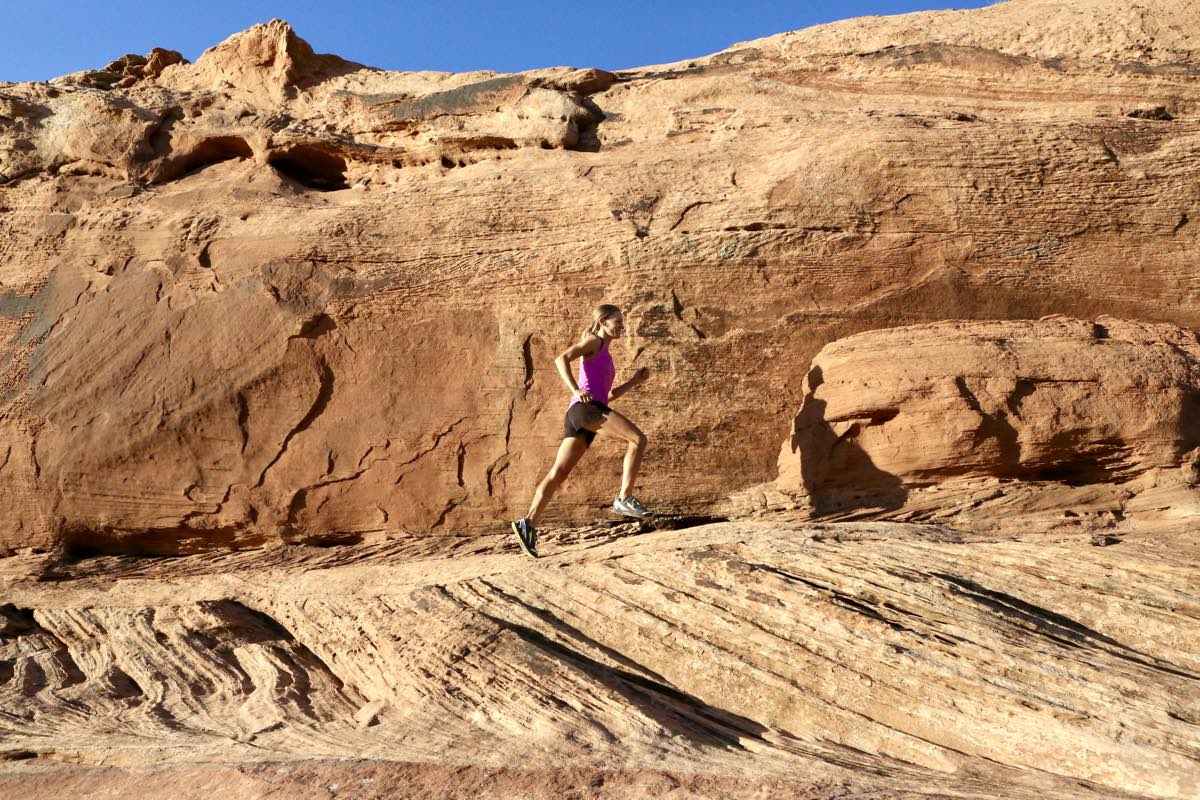
Like this article? Get your copy of the book “Where the Road Ends!”
Welcome to this month’s edition of “Where the Road Ends: A Guide to Trail Running,” where we’re talking about training for trail running.
“Where the Road Ends” is the name of both this column and the book Meghan Hicks and Bryon Powell of iRunFar published in 2016. The book Where the Road Ends: A Guide to Trail Running is a how-to guide for trail running. We worked with publisher Human Kinetics to develop a book offering the information anyone needs to get started, stay safe, and feel inspired with their trail running.
The book Where the Road Ends teaches you how to negotiate technical trails, read a map, build your own training plan, understand the basics of what to drink and eat when you run, and so much more.
This column aims to do the same by publishing sections from the book, as well as encouraging conversation in the comments section of each article. We want you to feel inspired and confident as you start trail running as well as connected to iRunFar’s community of off-road runners.
In this article, we excerpt from Chapter 8 and talk about training for trail running. If you’re reading this, then chances are you’re interested not only in being a trail runner but also in being a better, stronger, more comfortable trail runner. This article will help you make that happen!
When training for trail running, there are five basic types of workouts used by runners of all kinds:
- easy runs
- recovery runs
- long runs
- speedwork
- hill workouts
These five tools can make any runner better, and each has a distinct purpose. In this article, we discuss hill workouts. Click on the links below to dive into the three other parts of this four-part training mini-series:
Why Do Hill Workouts?
A trail runner looking to build strength quickly while improving aerobic capacity needs to look no further than their nearest hill. By varying the grades and lengths of the hills you charge up, as well the speed at which you run them, you can imitate every type of speedwork in a way that is specific to trail running. With stronger legs and an improved cardiovascular system derived from hill workouts, your ability to run hills can make your daily trail runs even more enjoyable.
Says Olympic marathoner and ultrarunner Magda Boulet, “I love incorporating long and short hill sessions into my training program. I like to balance hill workouts with speed workouts since both provide similar benefits of improving strength and economy, which is something that all runners can improve.”
Although you may instinctively think of training to run uphill, training for the downhill is important too. If you’re aiming to be a smooth and sturdy descender, a few types of workouts can help get you there. We’ll use the rest of this article to discuss several kinds of hill workouts.

Hill workouts can make you stronger, faster, and more efficient. They are also lots of fun! Photo: Human Kinetics/Kirsten Kortebein
Hill Fartleks
We learned about fartleks in this series last month, and a great way to get in a hill workout is to do a hill fartlek. If you’re brand new to trail running, you aren’t interested in more structured hill intervals, or you just want to have fun and be creative with your running, hill fartleks might be right for you.
Hill fartleks are made for the trails. Almost any trail, as long as it has some hills, is appropriate for this type of run. Carry out a hill fartlek as you would a regular fartlek run, except do the speed play on the uphills and the downhills of the trail and recover from those efforts on the flatter sections. Alternatively, you could focus your speed play solely on either the ascents or descents.
Note that you may need to curtail the length of your intervals if a hill is quite long. And don’t be afraid to roll back the effort a bit if the trail is really technical.
Structured Uphill Workouts
Uphill workouts are perfect for the trails! Seek trails with the appropriate gradient and degree of technicality for what you are trying to achieve with your workout. In general, the faster your uphill workout gets, the more you’ll appreciate smoother trails so that you can focus on the effort, not the terrain.
Choosing steeper hills for shorter intervals is a great way to develop strength and power. On the other hand, you’re likely better off finding a more gradual slope for workouts during which you’ll be pushing for stretches of 10 minutes or longer.
One easy way to recover during hill intervals is to jog or walk back down to where you began your previous climb. If you jog down, do so at a recovery-run effort, no harder. Always warm up before and cool down on calm terrain after your hard efforts.
Last month in this series, we learned about three types of speedwork: steady-state runs, tempo runs, and VO2max intervals. Click back to that article for a quick refresher. Great news — these speed workouts can be simply converted to hill workouts like this:
- Uphill steady-state runs. Run your uphill steady-state run up a long, continuous, mostly gentle uphill.
- Uphill tempo runs. For an uphill tempo run, find an uphill that’s long enough to accommodate the length of your tempo session. Adjust your pace to the steepness of the hill, so that your effort is at your lactate-threshold level.
- Uphill VO2max intervals. Again, the steepness of the hill defines your pace. Although you don’t necessarily need to run a steep hill to achieve VO2max effort, doing so will help you get into that zone quickly.
What About Downhill Workouts?
Strong downhill trail runners are a sight to behold, their bodies moving quickly and confidently among difficult terrain. Nothing can stop you from becoming one of them — you just need a little practice!
The purpose of running downhill repeats is different from that of running uphill intervals. Here, your goals are not to get an aerobic workout, although your heart rate may increase when negotiating a tough downhill. Instead, you’re looking to train the muscles of your core, hips, and legs as well as your nervous system to be fast, efficient, and durable when running downhill.
“Muscle Seasoning” Downhill Repeats
When you run hard downhill, you’re asking some of the muscles of your lower body to do a difficult thing: to be in a lengthened state while absorbing the impact of your body weight and the extra force created by your body’s mass descending.
It’s like asking someone whose arms are extended and carrying a large load to manage another bag or two. When exposed to such work, untrained muscles fatigue quickly while trained muscles can carry those loads for a long way.
Some trail runners say that muscles need to be “seasoned” to the act of running downhill, or strengthened by repeated exposure to and recovery from the extra work of downhill running. The quadriceps’ four muscles are the main muscles that need to be strengthened for downhill running because those muscles are significantly lengthened in the downhill-running motion.
The best place to run muscle-seasoning repeats is on descents of decent steepness and light to moderate technicality. Doing them is simple: Run downhill! Hike or run easily back uphill as the terrain dictates. Repeat until your quadriceps start feeling fatigued.
As you continue to season your legs for downhill running, once leg-crushing workouts will quickly become easy. That’s when you know you can increase your downhill workload.
How long should each downhill interval be? For those trying this workout for the first time, the downhill intervals should last no longer than five minutes each, and they can be repeated a couple of times. As your muscles become seasoned, you can increase the length and number of intervals.
The good news is that your quadriceps muscles don’t need much seasoning in order to stay strong for whatever downhill running you want to do. Scientific research has shown that you only need to run decently downhill every couple of weeks to maintain your strength for doing so.
Coordination Improvement Downhill Repeats
A whole different animal of downhill running, especially downhill running on technical terrain, is motor coordination. In trail running, a few key items contribute to our coordination:
- Muscles and joints of the feet communicate with the brain through the body’s central nervous system about the terrain under them and what is needed to negotiate it.
- With information collected visually, the brain analyzes a section of trail and decides what actions will be needed by what body parts to travel through it. The brain then uses the nervous system to command those movements by the body.
- Muscle groups communicate with each other through the nervous system about how much of the load each is going to take to perform a motion.
Your coordination is important whenever you’re trail running, but it’s especially important while descending because you’re moving faster with greater forces and have less time to react. The good news is that improving your downhill coordination is easy and fun.
Ideally, you should run downhill coordination improvement workouts on moderate or steep technical descents. In these places, the terrain requires your full attention, and all of your body parts must work in synergy with each other.
Your comfort level is important in choosing a spot for these workouts. Sometimes you’ll want to choose trails that are technically within your wheelhouse on which you can practice pushing your speed. At other times, you’ll want to push up to and perhaps beyond your technical comfort zone to work on becoming more comfortable on such terrain.
Both muscle and nervous system fatigue will occur when doing these intervals. For example, proprioception, which in trail running is the way that the muscles and joints of the feet communicate to the brain and rest of the body what they are encountering and how to react, lapses during fatigue. When you find it becoming mentally or physically challenging to negotiate the obstacles on the trail, that’s a sign to stop practicing them to avoid a dangerous fall.
Your overall approach to the volume of these downhill intervals should be similar to how you approach the muscle-seasoning downhill intervals in that you should start with small intervals, build up, and not overdo it until your mind and body adapt. In addition, you don’t need to do formal intervals if you care to incorporate meaningful and mindful descents into some of your training runs.
One last thought: Use care when running downhill! It has a huge impact on our body because of the extra forces derived in the motion. Always err on the side of caution when it comes to speed and volume to avoid injury.
Excerpted from Where the Road Ends: A Guide to Trail Running, by Meghan Hicks and Bryon Powell. Human Kinetics © 2016.
Call for Comments
- Do you do hill workouts? If so, what’s an example of a hill workout you incorporate in your training?
- Does running on hills come easy or hard for you?
- And, what’s easier for you, downhill or uphill running?

